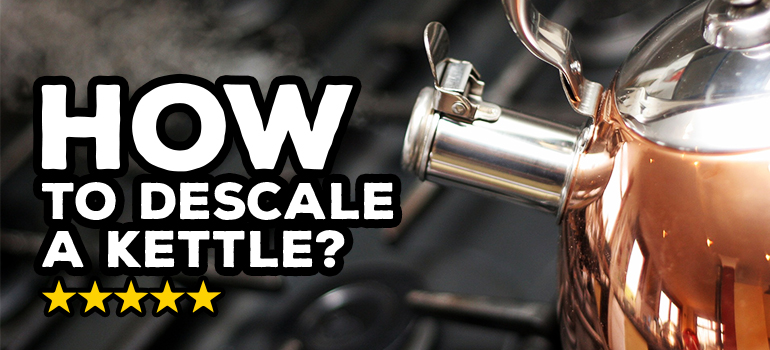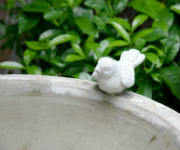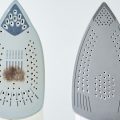
A scaly kettle isn’t something everyone cares about when it comes to making tea or coffee in the morning. After all, most appliances have a filter, and very few whitish flakes end up in the cup of hot beverage, right?
But what happens to your appliance’s performance over time if left unmaintained for long is another matter. In other words, removing the limescale deposits from your kettle now and again will ensure that your refreshing drink is free of undesirable particles, and the appliance will also “live” and serve you for longer. Not to mention that a limescale-free kettle is a green kettle, as it uses less energy.
So, read on if you want to learn how to descale a kettle. This post will delve into the best methods to clean hard water deposits from your appliance, regardless of its type (electrical or stove-top) and its material (high-grade steel, another kind of metal, plastic or glass).
Table of Contents
What causes limescale in kettle?
Recent research has stated that over 60% of the water in Britain is hard, containing high amounts of minerals. So, when the water in your kettle boils and evaporates, it leaves miniature deposits of those minerals. Over time, they build up and solidify, making them difficult to remove.
You will recognise limescale by the tough, milky deposits on the inside of your kettle. This is pure calcium carbonate and when left untreated, it can build-up to the point where it could clog up hard to clean spaces inside your kettle.
Scrubbing is not a good option to remove limescale, as it could damage the inside of the kettle. The good news is that mild acids are an effective option.
How to descale kettle naturally
Limescale contains compounds like calcium carbonate, magnesium bicarbonate and other forms of these two minerals. They can be effectively neutralised by acidic substances that are commonly found in almost every home. Such substances are vinegar, whether white, malt or made from cider, as well as lemon juice. Any one of these can help you successfully descale your kettle without worrying about harmful chemicals.
Furthermore, as Coca-Cola contains three types of acids, it can also be used as a kettle descaler. So if you leave it in contact with the scaly appliance for long enough, it may also be able to remove light limescale build-up.
Descaling a kettle with vinegar
- Pour some vinegar into your kettle until it is half full.
- Leave it to soak overnight so the acid can disintegrate the mineral deposits. If the kettle has a filter, you can remove it and soak it separately for the best results.
- In the morning, add water and boil the kettle for 2 to 3 minutes.
- Rinse well with cold water 2-3 times.
- You can, then, fill it with water and boil it again. This will help neutralise the smell of vinegar as well as clean away any residues.
How to descale a kettle with lemon
If you don’t have vinegar or don’t want to use it, you can replace it with lemon. Because of the citric acid, lemon is a natural and safe kettle descaler and effectively removes limescale leaving a fresh and pleasant smell. All you have to do is:
- Mix the juice of one lemon with approximately 500ml of water and fill the kettle halfway. Alternatively, you can slice the lemon and put it in the kettle adding cold water.
- Boil the mixture, then turn off the heat and let the descaling solution sit in the kettle for about 20 – 30 minutes.
- Remove the lemon mixture and rinse the kettle with fresh water.
How to descale a kettle with bicarbonate of soda
Another simple and effective method to descale your kettle is by using baking soda and water. To do so, follow these steps:
- Fill the kettle halfway with water and add 1 tablespoon of bicarbonate of soda.
- Boil the kettle. Turn off the heat and let the kettle sit for an hour.
- Remove the baking soda solution and rinse thoroughly.
How to descale a kettle with coke
If you have some left-over de-fizzed Coca-cola lying around, you can soak your kettle with it for the night and rinse the appliance the following day. The results will depend on how bad the limescale has affected the inside of your kettle, as Coke is not so powerful when it comes to neutralising hard water minerals.
If you have a stove-top kettle or an electrical one with an external heating element, you can sprinkle bicarb soda mixed with lemon and gently scrub the white encrustation from the bottom. For fancy glass kettles, the vinegar/lemon methods described above are the safest limescale removal technique.
Descaling a kettle with store-bought products
Most people avoid using chemicals and prefer natural descalers to remove limescale from a kettle. However, the manufactured kettle descaling solutions are acid-based. They are specially designed and safety-tested for drink and food preparation appliances. So they are not only safe to clean your kettle, coffee machine, pots, and pans, but also their formula has a stronger effect when it comes to eliminating limescale traces from your kitchen and drink-making appliances.
So, whether you choose a kettle descaler in a tablet, powdered, liquid or gel form, you just need to follow the manufacturer’s instructions to achieve the desired result.
In brief, the detergent solution is commonly diluted in water, first. Then, a similar boiling and soaking process follows to ensure that the mineral deposits are effectively dissolved. Finally, what you usually need to do is to give your appliance a good rinse with cold water.
In addition, using dental tablets to descale a kettle can also provide good results. Containing bicarbonate of soda and designed to sterilize, denture tablets dissolve in water and break down and dissolve limescale buildup. Just remember to empty out the tablet solution and rinse the kettle before using it again!
Things to be aware of when cleaning your kettle
Whatever method, natural or chemical, you have selected to clean limescale from your kettle, there are a few things to keep in mind. So, to make the most of it when descaling your appliance, give a thought to the following tips:
Natural descaling solutions
- Keep a 1:1 ratio when diluting the vinegar with water. Otherwise, if the acid is more than the water, the mixture may bubble over the kettle when boiling.
- Don’t boil Coca-Cola in your kettle, as some of the acids it contains will break down and will no longer have the same cleaning properties.
- Lemon fruit is not as effective as store-bought lemon juice or vinegar when it comes to neutralising even a mild limescale build-up.
- To get rid of the vinegar smell after cleaning your kettle, add a little lemon juice and a sprinkle of cinnamon during the second round of boiling.
- Don’t scrub bicarbonate soda on internal heating elements covered with limescale! You may damage their protective coating.
Store-bought descaler
- Descaling tablets are not only quite pricey but also rather weak. So, to save money and hassle, it’s best to consider purchasing a new-generation limescale remover.
- On that note, powdered descaling agents are very effective and will not break the bank.
- Always read the manufacturer’s advice on the product’s label, as different descalers are meant for use on different types of appliances based on the material they are made from.
- Don’t use any other limescale removal product you might have left over at home, even if it has been decorated with an all-purpose sign. Stay safe and purchase a descaling solution that is designed for kettles only.
- Kettles should not be cleaned with bleach, regardless of how many times you intend to rinse the appliance afterwards.
How to clean the outside of a kettle
The inside of your electric kettle indeed gets the worst limescale build-up. However, this doesn’t mean you should neglect the exterior of your appliance. Here is how to clean the outside of your kettle:
- Clean the exterior with dish soap. Use a microfibre cloth to rub dish soap on the exterior of the kettle to remove dirt, rust or fingerprints. Make sure to clean the kettle like this on a weekly basis. After you clean it, wipe it dry with a paper towel.
- Polish the exterior with olive oil. If you have a stainless steel kettle, you can polish it after the clean to keep it shiny like on the day you bought it. You can use olive oil for that, but you’ll get relatively the same result with baby oil or mineral oil. Just place some oil on a soft cloth and rub the exterior. Wipe it dry with a paper towel if you put too much on.
How to prevent limescale in the kettle
And isn’t prevention the best cure? So, clean your kettle as regularly as you can as a preventive measure by applying any of the above techniques, even when there is nothing to descale!
Also:
- Invest in a limescale catcher – These metal balls will effectively attract the mineral deposits and prevent limescale from lining the inside of your kettle.
- Descale your kettle once a month – It is very likely that you live in a hard water area, considering how large the UK’s hard water supply network map is. So, our advice is to descale your kettle routinely every month. Regular cleaning will help remove limescale buildup before it becomes too difficult to eliminate it.
- Don’t leave water standing for hours – You will promote limescale build-up even more if the water sits inside overnight before you need to use the kettle again in the morning. And think! Wouldn’t your tea taste better if you made it with fresh water?
- Don’t overfill your kettle: Overfilling the kettle can cause boiling water to spill out and leave limescale deposits on the heating element. That’s why to help your kettle last longer and prevent limescale build-up, make sure to only fill it with the amount of water you need.
Now that you’ve learned how to clean a kettle and avoid unpleasant limescale build-up, you just have to pick a date when you’re free from work and do it.
However, if you don’t want to spend your free time on something as tedious as cleaning, you can always rely on the professionals at Fantastic Cleaners. Call us today and see how they can help you with your household chores!
Need a helping hand around the house?
Enter your postcode to view our rates and availability in your area.
For questions about the services we offer visit our main site
What about cleaning a burned kettle?
It’s not uncommon to put the kettle on the burner and forget it there. The water would boil and evaporate. The moment there is no more fluid, the surface starts to burn. By the time you remember, you might be left with a damaged kettle. The truth is that kettles are designed to only hold a specific temperature for a specific amount of time. If the temperature passes their breaking point, they can lose their structural integrity.
It’s up to you to decide whether you dispose of the kettle after it’s been burned, or try to save it. Here are a few helpful tips on the matter.
- Wait for the kettle to cool down. Never attempt to assess the damage if you just removed the kettle from the burner. Wait for it to cool down on its own.
- Wash the kettle. Use general dish soap to thoroughly clean the exterior and interior of the kettle. Sponge away the caked ash and burn marks if there are any.
- Assess the situation. If your kettle withstood the wash, then you might have saved it in time. If your kettle is made of stainless steel, it’s most probably safe to use again, as long as the bottom is solid and the spout is straight.
Do you think that our post is worth sharing? Or maybe, you’ve got some helpful limescale removal or prevention tips? Go on! Let us know in the comments below!









A nicely written and informative piece! So I decided to comment here. But!
I do not want spam, so my details are entirely fictional!